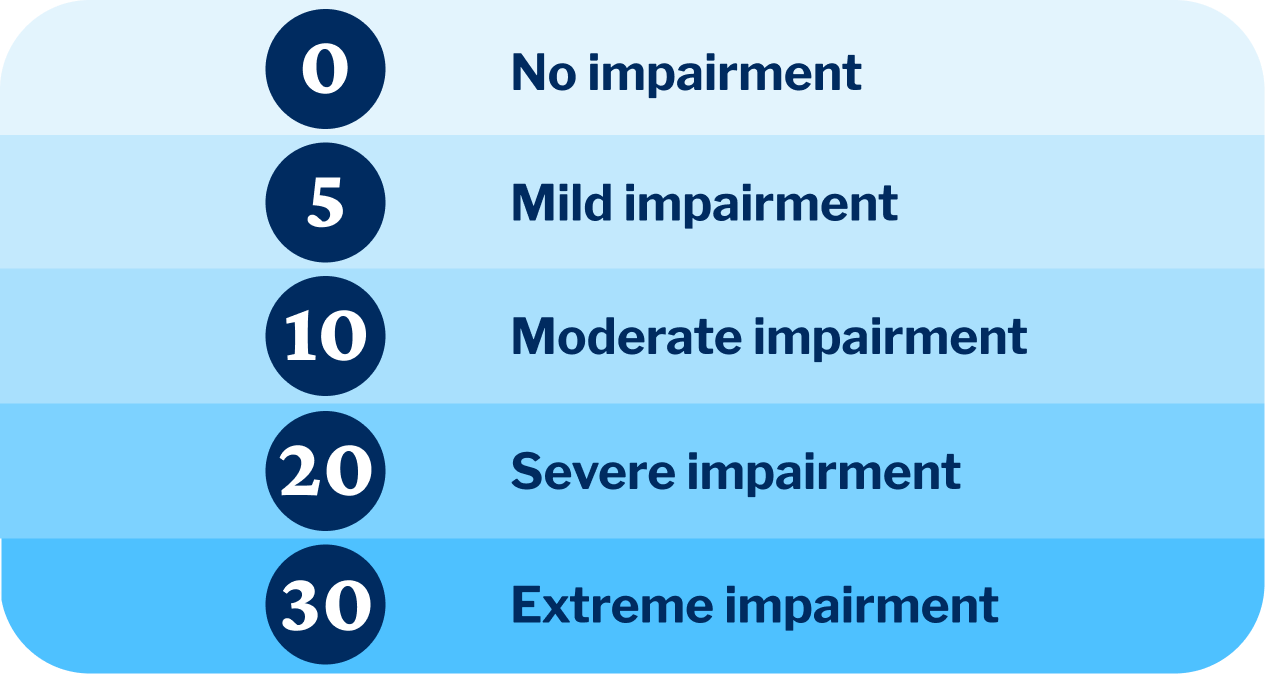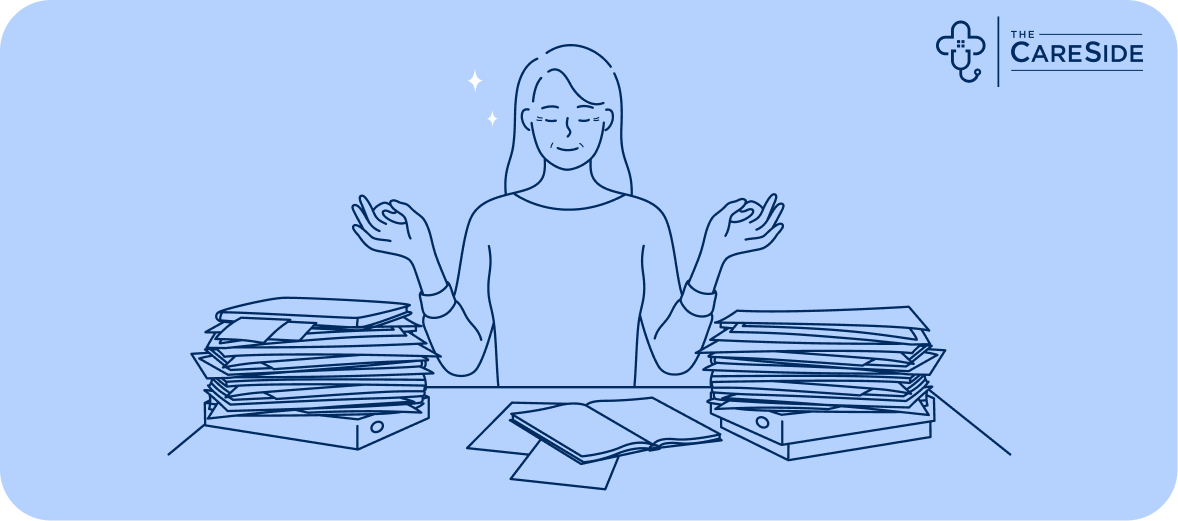If you are an Australian resident and have a permanent condition that prevents you from being able to work, then you might be eligible for a Disability Support Pension. A Disability Pension provides income support for people unable to work due to a physical, intellectual, or psychiatric impairment. If a medical assessor determines that you cannot work at least 15 hours a week for at least the next two years, then the DSP Pension provides income to support you.
Disability Support Pension Eligibility
To be eligible to receive a Disability Pension, you must meet both non-medical and medical rules. The non-medical rules are assessed first, and they include three criteria:
Non-Medical Rules
First, you must be between the ages of 16 and Age Pension age. The Age Pension age is 66 as of February 2021, and it will increase to 67 in July 2023. Visit Services Australia to learn more about age requirements.
Second, you must have been an Australian resident for at least 10 years in a row or a total of 10 years with at least five of them in a row. Generally, you must be both in Australia and an Australian resident when you apply to claim a Disability Support Pension, but there are exceptions. You might also be able to claim if you’ve lived in a country with an agreement with Australia, if you’re a refugee, or if you became unable to work or permanently blind while you were a resident of Australia or the dependent child of an Australian resident living somewhere else.
Third, you must be eligible according to the income and assets test. This means that your current income from all sources must be below certain limits for you to qualify, and your total available assets must also be below a certain limit. If you have non-work income even though you’re not able to work, then you may not qualify for a Disability Support Pension.
The income limit for a Disability Support Pension varies depending on your living situation, and the amount you’re eligible for may decrease if your income is higher. For example, a single adult who has less than $178 per fortnight in income could be eligible for a full DSP payment. For a single adult whose income is above $178 per fortnight, the possible disability pension amount is reduced by $0.50 for every $178. A single adult whose income is higher than $2066.60 per fortnight is not eligible for DSP payments.
You also need to financially qualify by the assets tests to be eligible for a disability pension. Assets include anything valuable you own. These could be financial assets such as money in checking accounts, cash, and stocks, or they could be income streams such as annuities. Real estate, businesses, and business shares also count as assets. Valuable contents in and near your home such as furniture, cars, boats, or livestock are assets as well. If you give away or sell an asset for less than it’s worth, then it could also count as an asset (this is to prevent you from giving away assets to become eligible for a pension). However, your principal home, along with up to 2 hectares of land where your principal home is located, does not count as an asset.
If you’re a single adult, you can own up to $268,000 if you’re a homeowner, or up to $482,500 if you’re not a homeowner, and still be eligible for a Disability Pension. Homeowners and non-homeowners are assessed differently because your principal home doesn’t count as an asset. Just like income, the asset limits vary depending on family and living situation.
If your assets are above the limit but you’re experiencing serious financial hardship, you can apply for an asset hardship provision. Severe financial hardship is defined as having readily available funds that are lower than a specific limit ($24,551.80 if you’re a single adult) and also having income that’s below the DSP limits. This could apply to you if you have significant assets that you can’t easily translate into cash by selling it or borrowing against it. For example, if you have a significant asset in the form of a second house that you’ve been trying to sell that’s listed at a reasonable marketplace but isn’t selling, then you might be able to qualify for an asset hardship provision. Learn more about the asset hardship provisions and how to apply. You’ll need to call Centrelink to apply for this exemption.
Medical Rules
If you meet all the eligibility requirements for non-medical rules, then you also need to meet the medical eligibility criteria. There are two categories of medical rules: manifest, and general. You only need to meet either, not both.
No matter what type of medical rules you qualify with, you’ll need to provide medical evidence. The specific type of evidence you need to provide depends on your condition.
Manifest Medical Rules
Manifest medical rules are assessed second, after non-medical eligibility. If you meet a manifest condition, then you won’t need any further medical assessment.
Six manifest conditions make you eligible for Disability Support Pension:
- Permanent blindness
- A need for ongoing nursing home care
- A diagnosis of a terminal illness with less than two years of life expectancy
- An intellectual disability with an IQ below 70
- Category 4 HIV or AIDS
- Receiving Special Disability Pension Rates from the Department of Veteran’s Affairs
For most of these conditions, you’ll need to provide medical evidence in the form of a letter from the doctor who treats you detailing your diagnosis, the disease stage, the treatment you’re receiving, and your prognosis. For nursing home care, your doctor will also need to provide information about how your condition impacts your ability to perform activities of daily living and how long you’re expected to need care. For permanent blindness, you’ll need to provide the Ophthalmologist or Optometrist Report Form or equivalent information. For intellectual disability, you’ll need a psychologist or school report describing your intellectual function, including your IQ test results. If you’re receiving a military SRDP, you’ll just need a letter from the Department of Veterans’ Affairs.
General Medical Rules
If you don’t have a manifest medical condition, you may still be eligible for a Disability Support Pension under general medical rules.
There are five conditions you must meet to qualify under general medical rules:
- Your condition must be expected to last at least two years or longer
- Your condition must be fully diagnosed, treated, and stabilised
- Your impairment rating must be 20 points or more
- You must meet the Program of Support rules if they apply to you
- Your condition must prevent you from working at least 15 hours a week.
More information about each of these criteria is described below.
The first two criteria are related: your condition must be fully diagnosed, treated, and stabilised, and it must be expected to continue unchanged for at least two years. For your condition to be fully diagnosed, a qualified health professional needs to examine you, diagnose your condition, and document it using appropriate medical evidence. If your doctor has referred you to a specialist, but you haven’t seen the specialist yet, then your condition isn’t fully diagnosed.
For your condition to be fully treated, you must have completed all reasonable and suitable treatments for the condition. This means you can’t be waiting for treatment that’s likely to improve your condition. For example, if you are waiting for a new or different treatment that might significantly reduce your impairment, then your condition isn’t fully treated. However, you can undergo regular treatments for your condition, as long as you aren’t planning or likely to need new or different treatment within the next two years.
In addition, your condition must be stabilised. This means that it isn’t likely to change or improve within the next two years. If you are currently undergoing treatment and your condition is improving as a result of treatment, then it’s not stabilised, and you are not eligible for DSP under this criteria.
Impairment Rating
The final Criteria are determined based on the Australian Impairment Tables, where your impairment rating must be 20 points or more.
What are the 20 points required for a disability pension?
Your impairment rating is based on the Social Security Tables for Assessment of Work-Related Impairment. These tables measure your ability to function and perform activities that would be required for a job.
Each table assesses a specific area of functioning, such as physical stamina, upper limb function, or visual function, and each table assigns points based on the level of impairment of that area of function. Impairment points for each area can be 0 (no impairment), 5 (mild impairment), 10 (moderate), 20 (severe), or 30 (extreme impairment).
Your condition can cause functional impairment in a single area and a single table, or it can cause impairment in several areas that are measured across two or more tables. If you have an impairment of 20 or more points in a single table, indicating a severe or extreme impairment in a single area of function, then you are eligible for Disability Support Pension. However, if you have 20 or more impairment points across two or more tables, indicating you have mild or moderate impairment in two or more functional areas, then you will also need to meet the Program of Support rules.
The Program of Support is a program that provides training and skills to help you find and keep a job. This rule only applies to you if you don’t have a manifest medical condition and you don’t have more than 20 points of impairment in a single table. If the Program of Support rule does apply to you, then you’ll need to participate in a program for at least 18 months during the 3 years before you claim DSP to be eligible. If you need to find a program, you can search for a Disability Employment Services provider in your area at the JobAccess website.
What about working on a disability support pension?
The final criterion under general medical rules is that your condition needs to prevent you from working at least 15 hours a week. Determining your eligibility under this rule might require that you get a Job Capacity Assessment, which involves meeting with a qualified health professional who will assess how your condition impacts your ability to work and what type of help you need to get a job. The assessment will evaluate whether you could retrain for a different type of job, as well as how many hours you could work if you had help, training, and support.
How Much is the Disability Support Pension per Fortnight?
The amount of money you can receive from a Disability Support Pension depends on your living situation and your income. In addition to the basic rate, your pension could include a pension supplement and an energy supplement.
If you’re a single adult 21 or older, the maximum basic rate is $860.60, the maximum pension supplement is $69.60, and the maximum energy supplement is $14.10, for a total of $944.30 per fortnight. Reference the payment rate charts to determine your maximum amount if you are a couple, an adult under 21, or a dependent.
The pension supplement is automatically included if you’re 21 or older, or if you’re younger than 21 and you have a dependent child.
The Energy Supplement is also automatically included with your Disability Support Pension, but it will be a different amount depending on your age and living situation. Both the energy supplement and the pension supplement will be included with your basic rate in your fortnightly payments.
You might also be able to get an advance payment on your Disability Support Pension if you need more money immediately than your usual fortnightly amount. You will have to pay the advance back over time, so it will be paid back out of your future payments over the next six months. There are limits to the amount an advance can be. Over a six-month period, you can get one advance at the highest possible amount, two smaller advances, or three advances of the minimum amount. For a single adult older than 21, the lowest advance amount is $446.40, and the largest is $1,339.20.
How to Apply for Disability Support Pension
If you meet the eligibility requirements for a Disability Support Pension, applying for DSP occurs online through your myGov account, over the phone by calling Centrelink, or in person at a service centre.
To submit a disability pension application, you’ll need to provide supporting documents. What documents you need will depend on the information you provide as you go through the process of submitting your claim. If you apply online, then the website will tell you as you fill out the claim what documents you need to provide. Some supporting documents will be required, and others will be supplementary. You’ll need all required documents before you can submit your claim, but supplementary documents can be submitted up to 14 days after the claim.
To find out what documents your claim will need, call Centrelink before you begin your claim. Explain your situation and how you believe you meet eligibility criteria for DSP, and they’ll be able to tell you what supporting documents you’ll need.
Common supporting documents include medical evidence such as medical history records, psychologist reports, and physical exam records; financial records such as bank account details, tax file number, and investments information; employment records such as income tax returns, payslips, and profit/loss business statements; living arrangement records such as rent certificate or proof of assets ownership documents; and relationship records such as marriage certificates, parent/guardian information, or proof of birth for dependent children.
To apply online, first set up a myGov account, then link Centrelink to your account. This will give you access to apply and manage your disability services online.
To apply by mail, print the appropriate form—either the Claim for Disability Support Pension for a Terminal Illness Form (if you have a terminal illness) or the Claim for Disability Support Pension Form for all other conditions.
Along with either of these forms, you’ll need to print and submit the Income and Assets Form. The Claim For Disability Support Pension Form also requires the Consent to Disclose Medical Information Form and the Claim for Disability Support Pension Form Medical Evidence Checklist Form. The last form includes a list of supporting documents for medical evidence, which will help you identify what documents you need to submit for your condition.
If you are unsure what documents you need to include, or if you don’t have access to a printer, call the Centrelink Disability, Sickness, and Carers Line to ask questions or apply by phone.
Additional Disability Support Available to Australians
If you’re not eligible for a Disability Support Pension payment, you may still qualify for other services or another type of disability support payment.
Other types of disability payments apply to job seekers. If you’re between the ages of 22 and Age Pension age and you’re temporarily unable to work due to an illness or injury, then you may be eligible for a JobSeeker payment. This payment is also available to people who are looking for work. Like the DSP, to be eligible for JobSeeker you must be a resident of Australia and meet an income and assets test. The maximum JobSeeker payments you can receive are lower than the maximum DSP, and the maximum income limit to qualify is also lower. A JobSeeker isn’t intended to support you for a long time; it’s temporary while you look for work or recover from a short-term condition.
You may also qualify for another type of disability support allowance. If someone you love has a disability and you provide regular care for them, then you may be eligible for a Carer Payment or a Carer Allowance. A Carer Payment is for someone who is unable to work because they provide constant care for a person with a disability or who is elderly and frail, and a Carer Allowance is for a person who provides additional (not constant) care. Both of these income support payments require that both the carer and the person who is disabled meets eligibility requirements, and both require an income test.
If you need additional support for services related to your disability, then you may be eligible for support through the National Disability Insurance Scheme. This program pays for services such as capacity building, technology, and personal care services. There are no income requirements for NDIS, but these funds are only for disability-related expenses, not for daily living expenses. You can receive both DSP and NDIS, but you need to apply for them separately.











